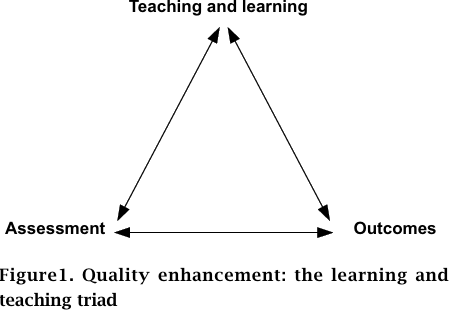
From quality assurance to quality enhancement
 المؤلف:
Chris Dillon & Catherine Reuben & Maggie Coats & Linda Hodgkinson
المؤلف:
Chris Dillon & Catherine Reuben & Maggie Coats & Linda Hodgkinson
 المصدر:
Enhancing Teaching and Learning through Assessment
المصدر:
Enhancing Teaching and Learning through Assessment
 الجزء والصفحة:
P283-C24
الجزء والصفحة:
P283-C24
 2025-07-22
2025-07-22
 410
410
From quality assurance to quality enhancement
As Coats (2003) points out, the LOTA project evolved rapidly from quality assurance to quality enhancement: "What is the difference? Quality assurance (QA) is about checking the standard of what is done; identifying 'good practice'; awarding classifications or scores. Quality enhancement (QE) is about improving and developing; not just doing things well but doing things better."
For LOTA quality enhancement means looking closely not only at the documentation and institutional processes but also at the way learning outcomes are actually being used. Just as importantly it also raises questions about how outcomes are being understood, not just by the academics in the faculties and course teams, but by the ALs who are in the 'front line' of distance teaching, and by the students themselves.
It quickly became apparent that the shift to an outcomes-based approach involved not only identifying learning outcomes and making sure that the assessment supported them, but also in involving staff in exploring how this process could be made meaningful to students such that it added value to their learning experience. The triad in Figure 1 emphasizes that outcomes, assessment, and teaching and learning are mutually connected, and should be seen as complementary aspects of quality enhancement. Underlying this triad are three main principles: transparency, transformation and transferability.
• Clearly identifying outcomes leads to transparency: teaching and assessment intentions are made explicit, and both tutors and students work with the same set of criteria to assess progress and to focus on ways to improve.
• Integrating formative and self-assessment, as well as summative assessment, into the learning process is transformative: students are encouraged to become actively involved in understanding how they are learning and how they can adapt their learning to new situations.
• Learning in a formal HE environment is about developing as an independent learner who can transfer the ability to learn effectively from HE into other, more educationally informal, environments such as the workplace.

Enhancing the quality of teaching so that it leads to transparent, transformative and transferable quality learning is the key role of academic staff development. Good staff development needs to prompt new thinking about the curriculum, and how students engage with it. Academics need to start from an outcomes perspective not only by asking the question 'what do we want students to get out of this course or program - and how can the assessment help them achieve and demonstrate it?', but also by exploring how students can answer for themselves the question 'what am I getting out my studies - and how can I explain and demonstrate what that is to others'.
The heart of the LOTA approach is about making things explicit so that there is a framework and a language for asking - and answering - these questions. Enhancing learning, therefore, is not just about improving assessment practices but about understanding how the outcomes - teaching-assessment triad underpins curriculum and staff development.
 الاكثر قراءة في Teaching Strategies
الاكثر قراءة في Teaching Strategies
 اخر الاخبار
اخر الاخبار
اخبار العتبة العباسية المقدسة


